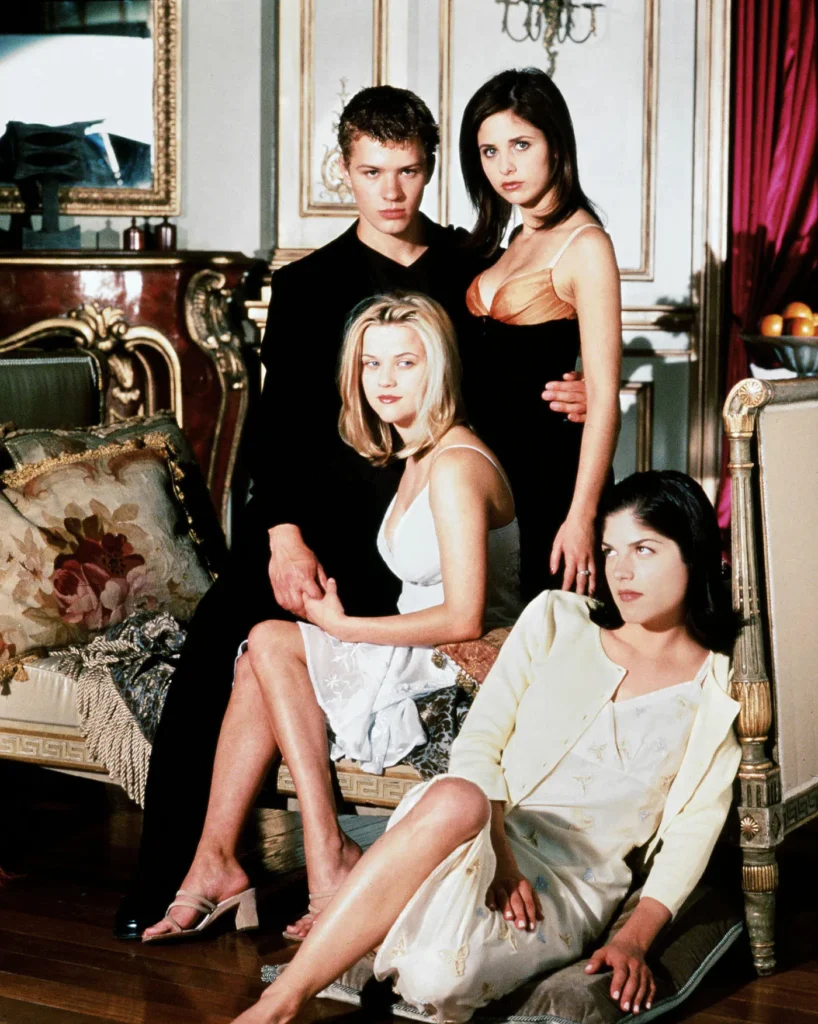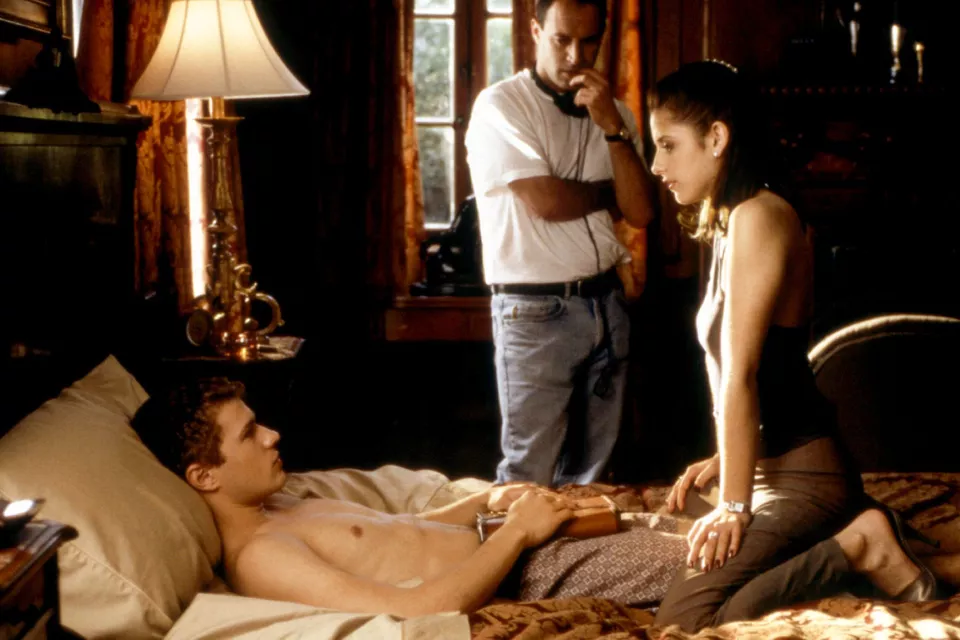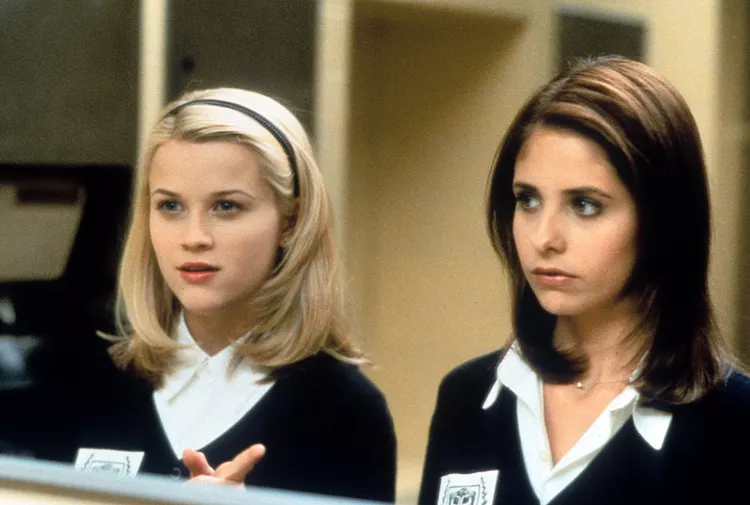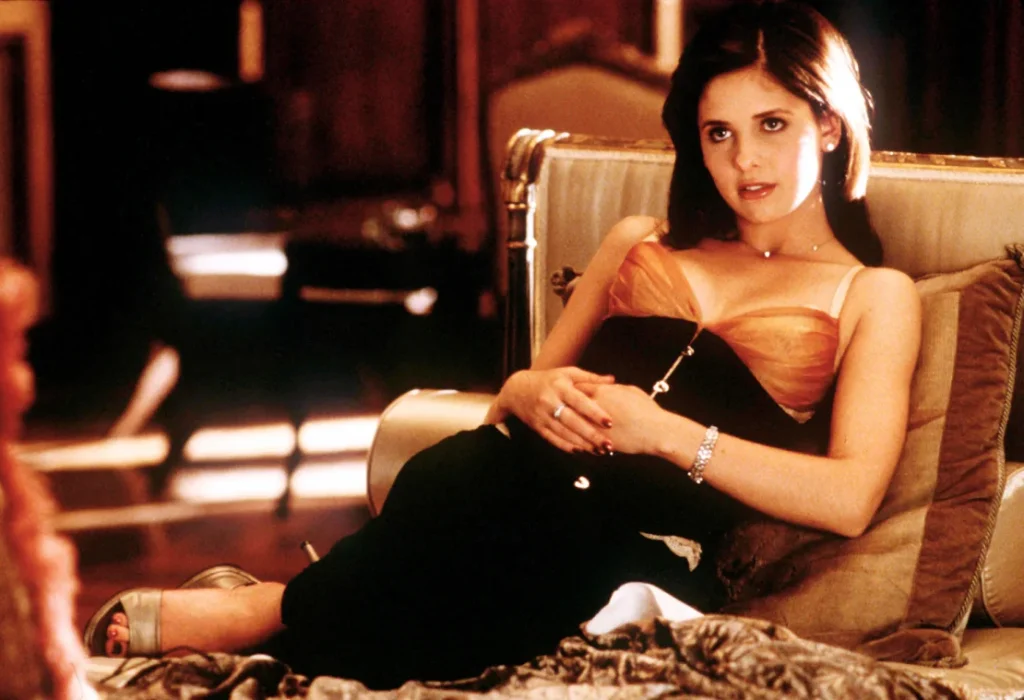In 1999, the cult classic Cruel Intentions by writer/ director Roger Kumble hit the screens. And 25 years later it’s still scandalous, it’s still cruel, and it’s still iconic.
The film is an adaptation of the 1782 French novel Les Liaisons Dangereuses but reimagined by Kumble in the modern world of Upper East Side teen socialites. Although set in a completely different century, just as in the novel, Cruel Intentions remains a tale of sex, betrayal, love and redemption.
Wealthy step-siblings Sebastian and Kathryn enjoy toying with people’s lives for their amusement and a particular quest turns into a bet: if Sebastian successfully seduces and deflowers their new headmaster’s virtuous daughter (Annette) before the new school year, Kathryn will finally have sex with him. And Kathryn’s other, more personal side-quest is to ruin the reputation of young and impressionable Cecile, who unknowingly charmed one of Kathryn’s ex-flings. As the sinful step-sibling duo manipulates their way into ruining the lives of two innocent girls, the game they’re playing leads to dangerous consequences.

Starring arguably one of the best casts, the film has Sarah Michelle Gellar as Kathryn Merteuil, Ryan Phillippe as Sebastian Valmont, Selma Blair as Cecile Caldwell and Reese Witherspoon as Annette Hargrove.
To celebrate the 25th anniversary of Cruel Intentions, we spoke to the film’s writer/ director Roger Kumble to find out more about the making of this ‘90s classic. (Kumble is also behind movies like The Sweetest Thing , Just Friends, After We Collided and Beautiful Disaster)

You recently attended the 25th anniversary screening of Cruel Intentions at Village East Cinema in NYC. How many times have you seen the film since its release? Do you enjoy rewatching your work, especially with fans present?
RK: I always go into it kind of like “Ugh I don’t wanna watch this,’’ because when you finish a film, you’ve seen it fifty times if not a hundred times. So you’re kind of like, I’d rather watch something new. But it is more watching the audience than watching the film, so that part of it is kind of interesting. What’s been nice about this year is I’ve done three Q&As and what was surprising was [that] over half the audience hadn’t seen the film. I thought it was just gonna be super fans, so that was cool. I’m like, ‘‘Wow, new people are discovering this movie and they seem to enjoy it.’’
It seemed to withstand the test of time.
Why do you think the film still attracts and resonates with newer, younger audiences even after 25 years?
RK: I think it’s because a lot of people identify [with it]. You know, it’s a tragedy and I always think it resonates more. I think people identify with all of them—with not only just Sebastian and Annette, but a lot with Kathryn. She’s not just a one-dimensional villain. There is a little girl inside of that character.
How did you initially come up with the idea to adapt an 18th-century novel but make it into a ‘90s teen drama?
RK: The inspiration was (this was back in the ‘90s ), I had seen this film called Welcome to the Dollhouse. It’s incredible [and] it was really kind of the first time I’d seen ‘mean teens’. I was very moved by it. And then also, I grew up in Westchester County, New York and I’d worked at a video store. I’ve seen all the movies and I’d seen Roger Vadim’s Dangerous Liaisons (1959)—he took this novel and modernized it. Now at the same time, there was a slew of adaptations: Christopher Hampton brought it to the stage, brilliantly. To me, the ultimate Valmont was Alan Rickman. And then they did the [Stephen] Frears movie with Malkovich and Miloš Forman did the one with Colin Firth.
Literally what happened was, I’d just finished writing and directing this play in LA that was a hit, with David Schwimmer. And before that, it was like the movie God kind of strikes with a good idea—I was on a corner and a voice said: what about Dangerous Liaisons in high school?
How did the vision for a prep school world with socialite teens and the movie’s overall aesthetic come about?
RK: You know, because I had written it on spec and it was gonna be my first film, I had written it to be made as a million-dollar indie movie. So I had no intention of ever filming the school or anything like that. But the ending of the movie was a reshoot and I actually paid for part of it out of my own pocket. But I will say, I’m going to give credit, [for] the visual aesthetic, to my visual team.
Because I was a first time director, I was solely focused on the performances and the script. I kind of said, ‘‘Help me here, here’s the world I wanna create.’’ I think, ‘‘They should all have uniforms’’ is as much as I said. And my comment was [that] even though they have uniforms, Kathryn and Annette should wear them differently.

When adapting the characters from the book—which character was the easiest to imagine as a ‘90s teen and who was more difficult to adapt?
RK: I think the hardest was Annette. I know it was. I’d say the rest were easier for me. Annette was the hardest without making her seem priggish. When Reese came on board, she helped me with the last draft of that character, she wrote it with me. So she came over and took a pass at it with me for a few days before she signed up.
Do you have a favorite scene that stands out to you ?
RK: I think my favorite scene in a way is that second scene when we introduce pretty much everybody except Annette. I come from theater and it’s like a twelve-page scene–it really is a play. Because of that scene, you’re invested in the characters. You’re not cutting away from them, you just stay with them the whole time—it’s kind of crazy. I’m even surprised that back in 1998 when we filmed it, the studio let us get away with it.
Casting wise, how did you end up with the core cast: Ryan Phillippe, Selma Blair, Sarah Michelle Gellar and Reese Witherspoon? You mentioned I Know What You Did Last Summer—is that how you ended up casting Ryan and Sarah in the film?
RK: Yes, Sarah and Ryan worked with my producer Neal Moritz. And Selma, I met through auditions. We couldn’t figure out who was going to play Annette and then I was hanging with Ryan and said, ‘‘What about your girlfriend?’’ So we took her out and tried to get her drunk to get her to do it—and I ended up getting drunk and got on my knees and begged Reese to do the part.

Did you have a favorite duo/ on-screen chemistry to direct in Cruel Intentions?
RK: I love them all, I really do. I know that’s a bullshit answer but whoever I was working with at the time, I was so excited to be working with. I mean I hated filming the breakup scene but it’s such an amazing scene, you know, so I love that scene [with Ryan and Reese]. But I loved working with Ryan and Sarah. And I loved working with Selma. And Sean Patrick Thomas and Christine Baranski. Such a great break as a first time director to be working with this cast.

I’m a Kathryn apologist since day one. So can you tell me a little about writing her ‘‘I’m the Marcia F*cking Brady of the Upper East Side and sometimes I want to kill myself’’ monologue?
RK: In the book, there’s a letter from Marquise de Merteuil where she kind of describes her ‘win or die’ speech. I said that needs to be included [in the film] where she sums up who she is. So that was basically me trying to modernize that letter—and I guess it landed, you know? I’m proud of that because it still resonates with people and with women. It’s the frustration of being not respected.

Most people wouldn’t instantly describe Cruel Intentions as a comedy, it comes off as more of a drama—especially with the heavier subject matters. But when I actually think about it, it is pretty funny. And having briefly interned alongside you during the making of Beautiful Disaster, I know you like inserting comedic moments into your films. So how did you use comedy in Cruel Intentions?
RK: Yes I agree. I think one of the reasons the movie still works is because I came from a world of comedy. Because of that, if you look at the film again, you see that I took very uncomfortable situations and I kind of have a light comedy approach to them. I didn’t know it at the time. It wasn’t until a few years ago when I rewatched the film that I was like, ‘‘Oh wow, this is why this movie still works.’’
(Spoiler) Some people are devastated by the ending since it’s not your typical happy teen movie ending. But once I read the novel, I was like ‘‘Ah, yes.’’ Did you ever consider changing Sebastian dying at the end or did the studio propose a no-death ending?
RK: Great question. So when we tested the movie, it tested poorly. And when we looked at the cards— why didn’t you like this movie?—it was unanimous: ‘‘You killed them’’ And I was like oh shit they’re gonna make me reshoot this movie. Fortunately, the head of the studio was Amy Pascal (who is now a fantastic producer, she just produced Challengers) and she said [they] scored the movie low, because they’re in love with Sebastian. In the hands of a studio head who didn’t have that kind of insight, I probably would have had to reshoot it. So, thank god.
I always knew we had to kill him. If I didn’t, it would have been fluff. But I did kind of change the ending, I didn’t make it so awful. I didn’t give [Annette] leprosy. The ending is pretty horrible in the book. I did lighten it up a bit, in that aspect.
Did you have any other no-brainer decisions on your part ?
RK: The biggest fight I had when I wrote [the script] and I was going around to sell it [was that] everyone wanted it but everyone was like, ‘‘Could you make it in college?’’ and I said no. If we made it in college, it just doesn’t have the weight—it’s like, so what? The fact that they are in high school makes it kind of terrifying.
The soundtrack feels very authentic. To me, it sounds like someone’s personal mixtape rather than fabricated for Hollywood. Can you tell me a little bit about the music in the film—how involved were you in soundtrack decisions?
RK: Yes! It kind of was a mixtape of mine. I wrote Bitter Sweet Symphony into the script. I was listening to it when I wrote the ending—I wouldn’t recommend that, it ended up being a fortune, that song. That Britpop kind of sensibility was what I was listening to back then and when I was growing up. We landed with Virgin Records and I was able to get Blur into the movie. It was great.
Do you have a favorite song & scene pairing from the film?
R: I mean, Bitter Sweet Symphony…. But the coolest was, I had the song To Sheila by The Smashing Pumpkins for when Sebastian tracks [Annette] down at the train station and then they make love. At the last minute, Billy Corgan pulled the song. And then as we’re trying to find a song, I get a call that Adam Duritz from the Counting Crows saw the movie and really likes it and has a song that he thinks that would work. And I heard Colorblind and I was like ‘‘This is amazing.’’ Then he’s like, ‘‘Hey, do you wanna come over and hear us record it tonight?’’ and I was like, ‘‘F*ck yeah!’’
During Cruel Intentions, what is something you learned or discovered as a first time director? Something that you still bring with you into directing movies now.
RK: I mean really surround yourself with the best people. In my case it was my production designer, my costume designer and my DP, and my editor.
One thought on “25 Years of Cruel Intentions: Interview with Director Roger Kumble”
Comments are closed.